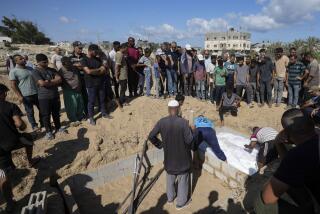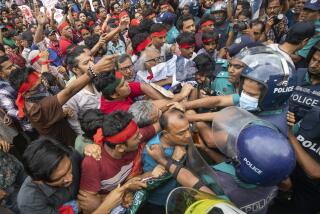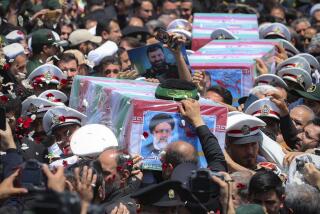Iran security forces retreat as huge numbers of mourners gather at cemetery
BEIRUT AND TEHRAN — Protesters swarmed Tehran’s main cemetery and fanned out across a large swath of the capital Thursday, defying truncheons and tear gas to publicly mourn those killed during weeks of unrest, including a young woman whose death shocked people around the world.
The protests marked the 40th day since the shooting of Neda Agha-Soltan was captured on video and posted on the Internet. For Shiite Muslims, the 40th day has religious importance, often an occasion for an outpouring of emotion and grief.
Thirty years ago, such commemorations helped build momentum for the Islamic Revolution, which overthrew the shah. The resilience of the thousands of protesters this time set the stage for more clashes next week, when hard-line President Mahmoud Ahmadinejad is to be inaugurated for a second term despite allegations that he won only because of widespread fraud in the June 12 election.
The scale and reach of Thursday’s protests, which also erupted in at least four other cities, appeared to catch security forces off guard. After initially bloodying some of the mourners arriving at Behesht Zahra cemetery, many of them young women dressed in black and carrying roses, officers stepped back. They mingled amicably with protesters, and in one case even accepted flowers from them.
The mourners chanted political slogans as they rode the Tehran subway from the city center to the cemetery and back. When they returned to the center, they took to the streets, first in the area of the Grand Mosala Mosque, where they had been banned from gathering.
Later, on side streets and main thoroughfares, they were occasionally attacked by baton-wielding security personnel, some on motorcycles.
But they were also cheered on by thousands of well-wishers honking car horns ferociously or hanging out the windows of apartments and buses. They clogged roadways and tunnels, holding up signs in support of opposition leader Mir-Hossein Mousavi. Shopkeepers handed out bottles of water to sustain the demonstrators in the heat.
“Honorable Iranians,” the protesters chanted. “Today is a day of mourning.”
And in a challenge to a harsh crackdown on the news media, they recorded everything and quickly flooded the Internet with amateur videos of the day’s events in the capital as well as the provincial cities of Esfahan, Shiraz, Ahvaz and Rasht.
“Death to the dictator,” chanted those in one long procession heading toward Agha-Soltan’s grave, kicking up a storm of dust as they walked. “Neda is not dead. This government is dead.”
As night fell, witnesses reported intense confrontations between demonstrators and security forces in north-central Tehran. Trash bonfires that had been created to counter the effects of tear gas belched black smoke into the sky. Residents nearby hurriedly took injured protesters into their homes to protect them from roaming bands of Basiji militiamen.
Iranian officials say 30 people have died in unrest since the election. But human rights monitors and independent observers say the number killed in the protests and subsequent crackdown is at least twice that in the capital alone.
On Wednesday, the Paris-based monitoring group Reporters Without Borders urged authorities to explain the death of journalist Alireza Eftekhari on June 15. His body was handed over to relatives on July 13. A news release said Eftekhari died from a severe beating.
Authorities have tried to quell the unrest using the coercive instruments of the state, angering even some of Ahmadinejad’s conservative allies.
On Wednesday, the Tehran prosecutor’s office announced the latest in a series of arrests of prominent political figures: Saeed Shariati, a member of the central committee of the Islamic Iran Participation Front, the nation’s primary reformist grouping.
Authorities also said they would place the first group of protesters on trial. According to a statement by the prosecutor’s office, they will be charged with offenses that include having ties to terrorist organizations, invading and setting fires at military bases, destroying public property, looting, and preparing and dispatching news reports for “enemies” of the Islamic Republic.
Still, under massive domestic and international pressure, officials also have acknowledged wrongdoing by authorities. Supreme leader Ayatollah Ali Khamenei this week ordered the Kahrizak detention center south of Tehran closed because its facilities were “substandard.”
Iran’s police chief, Gen. Ismail Ahmadi Moghaddam, said some officers “went to extremes” during the protests.
Two prominent jailed reformist politicians, Behzad Nabavi and Mostafa Tajzadeh, were allowed to phone their families from prison for the first time since they were arrested June 13.
And authorities moved Saeed Hajjarian, who was critically wounded in a 2000 assassination attempt, from prison to a detention house with medical facilities, the Mehr news agency reported.
But such steps may not be enough to appease an emboldened opposition, which is supported by a grass-roots political movement unlike any the Islamic Republic has experienced.
Former President Mohammad Khatami, speaking to a group of reformist lawmakers, called for an investigation into allegations of torture and murder.
“Crimes have been committed. Lives have been lost and immoral treatments have been meted out to our dear youths, women and men,” he said. “With the supreme leader’s order of closure [of Kahrizak], a fresh opportunity has come up to launch an inquiry into the tragedy and punish the perpetrators.”
Among the demonstrators, spirits seemed to be rising.
“We cannot foresee any reconciliation between the two camps,” said Reza, a 25-year-old at the cemetery who did not want his last name used. “So we go for collapse of the entire system in the long term.”
Hamid, a 24-year-old engineering school graduate from what he described as a wealthy family, said he’d given up his previously luxurious lifestyle to devote himself to undermining the government.
“A general strike won’t work now,” he said. “These demonstrations are better than strikes because with a smaller number of people we . . . make them fear for tomorrow.”
Parisa, a 22-year-old college student, said she had already been in so much trouble with the authorities and her college that there was no turning back.
“Whether I come to the demonstrations or not, the authorities will be keeping an eye on me forever,” she said.
Mousavi and his wife, Zahra Rahnavard, tried to attend the mourning ceremony but were prevented by security forces, who in some cases appeared divided over whether to beat the demonstrators or guide them toward Agha-Soltan’s grave. An amateur video showed mourners surrounding police officers lounging on an official vehicle, chatting amicably.
One witness estimated that 10,000 people flooded into the cemetery. Another, 30-year-old Koroush, said from a bridge that he could see thousands more were outside the grounds, unable to get in.
One person who wasn’t there was Agha-Soltan’s mother, Hajer Rostam Motlagh.
Many of the parents of those who have died have been warned not to publicly mourn, but she had vowed that she would attend the gathering.
Motlagh instead went to a park near her home. A photograph showed her sitting cross-legged on grass before a single candle. In an interview with BBC Persian this week, she said she didn’t want people to forget her daughter, a former student of Islamic philosophy who had cultivated a passion for music and travel. And she said she had a message for the world.
“I want you, on my behalf, to thank everyone around the world, Iranians and non-Iranians, people from every country and culture, people who in their own way, their own tradition, have mourned my child,” she told the interviewer. “Everyone who lit a candle for her, every musician who wrote songs for her, who wrote poems about her, I want to thank all of them.”
--
Mostaghim is a special correspondent.
More to Read
Sign up for Essential California
The most important California stories and recommendations in your inbox every morning.
You may occasionally receive promotional content from the Los Angeles Times.










